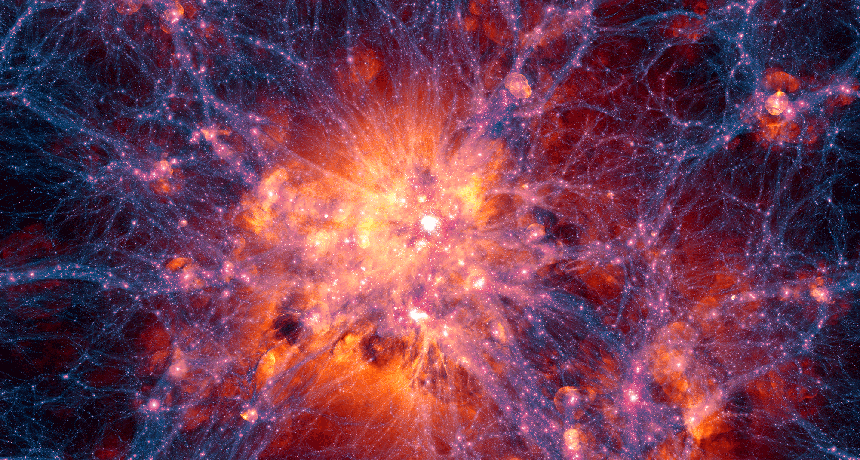Ancient light may point to where the cosmos’ missing matter hides
A new technique might have found the protons and neutrons unaccounted for in the universe

Astronomers have been puzzled by the apparent absence of some ordinary matter throughout the cosmos. A new computer technique has now found hints at where it might be. It shows galaxies (pink) strung like beads along long filaments of dark matter (blue). Most of the ordinary matter is probably stored in gas (orange).
Illustris Collaboration/Illustris Simulation
There’s been a problem with the universe. Some matter has been missing — the ordinary type that makes up atoms. The good news: Astronomers say they may have found it.
Scientists think this missing matter is hot gas. It appears to be lurking in spaces between clusters of galaxies. Previous studies had hinted where this missing matter might be hiding. A new search technique now is helping home in on where it resides. Astronomers described online the technique they used in a pair of papers posted September 15 and 29 at arXiv.org.
Finding this missing matter is important, says Dominique Eckert. He is an astronomer at the Max Planck Institute for Extraterrestrial Physics in Garching, Germany. He did not take part in the new work. He has, however, searched for the missing matter. It is made of protons, neutrons and other select subatomic particles. Scientists sometimes refer to these as baryons (BEAR-ee-ahns). “If you want to understand how galaxies form and how everything forms within a galaxy, you have to understand the evolution of the baryon content,” says Eckert. And that starts with knowing where those baryons are.
Astronomers know that about 85 percent of the matter in the universe is dark matter. This stuff is mysterious and elusive. And it’s not made of baryons. It doesn’t emit light (which is why it’s literally dark). It’s also different from ordinary matter.
In contrast, ordinary matter makes up only about 15 percent of the mass of the universe. It is what is in us and all around us. Weirdly, about half of even this type of matter does not show up astronomers scan the skies. As they look at galaxies within the nearest few billion light-years from Earth, they find only about half the baryons that should have been produced in the Big Bang. (That’s the rapid expansion of dense matter in the universe. According to current theory, the Big Bang marked the origin of the universe. )
The rest of the ordinary matter is probably hiding in long strands, or filaments, of gas. These strands connect clusters of galaxies in a vast cosmic web. Previous attempts to find the missing baryons focused on X-rays emitted by the gas. Astronomers also looked at how the light coming out certain of bright, distant galaxies, called quasars, filtered through these cobwebby strands. Still, that missing ordinary matter had remained a no-show.
Now some scientists have scouted for the missing matter in a new way. Hideki Tanimura is a cosmologist at the Institute of Space Astrophysics in Orsay, France. He did this research while working at the University of British Columbia in Vancouver. Anna de Graaff is an astrophysicist in Scotland at the University of Edinburgh. She worked as part of another team.
Each group found a way to look through the gas. They peered all of the way back to the oldest light in the universe.
Accounting for cosmic clouds
That ancient light is known as the cosmic microwave background. It is residual heat that was emitted some 380,000 years after the Big Bang. As it beams through space, this light passes through clouds of electrons, which are negatively charged particles. Filaments of hot gas host these electron clouds. As the cosmic microwave background passes through these clouds, they deflect and distort the light in a particular way. In 2015, a satellite helped create an all-sky map of those distortions.
Tanimura and de Graaff separately figured that there should be more distortion along the filaments than in empty space. To locate the filaments, both teams focused on pairs of galaxies from a catalog known as the Sloan Digital Sky Survey. The galaxies they chose had to be at least 20 million light-years apart. De Graaff’s team chose roughly a million pairs of those galaxies. Tanimura’s team chose 262,864 pairs. Both groups assumed that the galaxies were not all part of some galaxy cluster. But they should be connected by a filament.
Individually, those filaments were too faint to see. To bring them into view, the teams used computer software. It layered all of the images. Then, each team subtracted out distortions that any clouds of electrons would have produced. This revealed a residual distortion in the cosmic microwave background. Both groups saw it and now link it to the presence of those filaments.
“Filamentary gas is very difficult to detect,” Tanimura says. “But now we have a technique to detect it.”
De Graaff’s team calculates that those filaments must account for about three in every 10 baryons throughout the universe. And that’s likely an underestimate. After all, her team notes, it didn’t examine every filament in the universe.
Michael Shull is an astrophysicist at the University of Colorado Boulder. “Both groups here took the obvious first step,” he says. “I think they’re on the right track.” Still, he worries that the gas they see might come from another source. It could have been ejected from galaxies at high speeds. If true, he says, it might not be the missing matter after all.
Eckert also worries that the gas may belong more to the galaxies than to their intergalactic tethers. Future observations of what the gas is made from, he says, along with more sensitive X-ray observations, could help solve that part of the puzzle.







